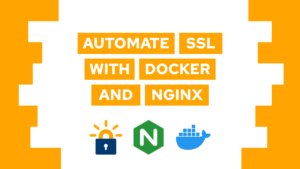The most important Docker Compose properties
Do you want to have the most important properties of docker-compose in one place? Here you get a short overview of the properties and additionally a simple cheat sheet that you can use!
In this post, I will explain the different sections and properties of the cheat sheet that you can download here!

VPS Hosting Course
Learn everything you need to know about servers and hosting your own applications!File structure
This shows the basic structure of every docker-compose file. With the basic settings that can be a docker-compose.yml or a docker-compose.override.yml.
services:
container1:
properties: values
container2:
properties: values
networks:
network:
volumes:
volume:YML Types
Each compose property has one or multiple possible types. The different possibilities are a basic key:value, an array, or a dictionary.
Value
key: valueArray
key:
- value
- valueDictionary
master:
key: value
key: value[convertkit form=2649016]
Properties
There are a few possible properties that you can use in a container. The most important ones are listed here with a short description, the type, and an example of how to use it.
Need help or want to share feedback? Join my discord community!
build (value)
Build an image with the specified name by using the Dockerfile in the specified directory.
container:
build: ./path
image: image-nameimage (value)
Use an image that is on the system or that can be downloaded from the docker hub.

If this guide is helpful to you and you like what I do, please support me with a coffee!
image: image-namecontainer_name (value)
Specify the container name, that the container will be accessible with.
container_name: namevolumes (array)
Create container volumes to persist data and to make certain directories available on the host system.
volumes:
- /path/to/host-dir:/path/to/container-dircommand (value)
Overwrite the start command of the container.
command: command-to-executeenvironment (dictionary/array)
Define environment variables to use inside of the container.
environment:
KEY: VALUE
---
environment:
- KEY=VALUEenv_file (dictionary/array)
Define environment variables inside a .env file to use inside of the container. The environment variables specified in the file will override the variables specified in the environment property.
env_file: .env
---
env_file:
- .envrestart (value)
Specify a restart rule for the container. (no, always, on-failure, unless-stopped)
restart: unless-stoppednetworks (array)
Define the networks a container should be attached to.
networks:
- network-nameports (array)
Define ports to expose to other containers and the host system.
ports:
- "9999:9999"expose (array)
Define ports to expose only to other containers.
expose:
- "9999"network_mode (value)
Set the network driver for the container. (bridge, host, none, service:[service name], container:[container name/id])
network_mode: hostdepends_on (array)
Specify the build, start and stop order of the container.
depends_on:
- container-nameOther
idle container
Define the command, to make the container do nothing! The container will not stop and it is possible to enter it without problems. Mostly only needed for debugging.
command: tail -f /dev/nullnamed volumes
Create named volumes that can be used in the volumes property. More information.
services:
container:
image: image-name
volumes:
- data-volume:/path/to/dir
volumes:
data-volume:networks
Create new networks that can be used in the network’s property. It will specify the name and the network driver. More information.
networks:
frontend:
driver: bridgeI hope you can make use of this collection of the most important docker-compose properties. If you think I missed something, you have some questions, or just feedback comment below or send me an email at mail@programonaut.com!



